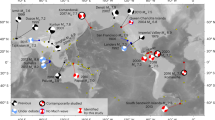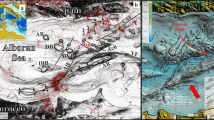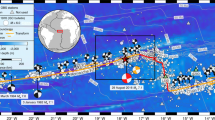Abstract
East Pacific Rise transform faults are characterized by high slip rates (more than ten centimetres a year), predominately aseismic slip and maximum earthquake magnitudes of about 6.5. Using recordings from a hydroacoustic array deployed by the National Oceanic and Atmospheric Administration, we show here that East Pacific Rise transform faults also have a low number of aftershocks and high foreshock rates compared to continental strike-slip faults. The high ratio of foreshocks to aftershocks implies that such transform-fault seismicity cannot be explained by seismic triggering models in which there is no fundamental distinction between foreshocks, mainshocks and aftershocks. The foreshock sequences on East Pacific Rise transform faults can be used to predict (retrospectively) earthquakes of magnitude 5.4 or greater, in narrow spatial and temporal windows and with a high probability gain. The predictability of such transform earthquakes is consistent with a model in which slow slip transients trigger earthquakes, enrich their low-frequency radiation and accommodate much of the aseismic plate motion.
This is a preview of subscription content, access via your institution
Access options
Subscribe to this journal
Receive 51 print issues and online access
$199.00 per year
only $3.90 per issue
Buy this article
- Purchase on Springer Link
- Instant access to full article PDF
Prices may be subject to local taxes which are calculated during checkout






Similar content being viewed by others
References
Jones, L. M. & Molnar, P. Some characteristics of foreshocks and their possible relationship to earthquake prediction and premonitory slip on faults. J. Geophys. Res. 84, 3596–3608 (1979)
Abercrombie, R. E. & Mori, J. Occurrence patterns of foreshocks to large earthquakes in the Western United States. Nature 381, 303–307 (1996)
Felzer, K., Abercrombie, R. E. & Ekstrom, G. A common origin for aftershocks, foreshocks, and multiplets. Bull. Seismol. Soc. Am. 94(1), 88–98 (2004)
Helmstetter, A., Sornette, D. & Grasso, J.-R. Mainshocks are aftershocks of conditional foreshocks: How do foreshock statistical properties emerge from aftershock laws. J. Geophys. Res. 108, doi:10.1029/2002JB001991 (2003)
Dodge, D. A., Ellsworth, W. E. & Beroza, G. C. Detailed observations of California foreshock sequences: Implications for the earthquake initiation process. J. Geophys. Res. 101, 22371–22392 (1996)
Geller, R. J., Jackson, D. D., Kagan, Y. Y. & Mulargia, F. Earthquakes cannot be predicted. Science 275, 1616–1617 (1997)
Hirose, H., Hirahara, K., Kimata, F., Fujii, N. & Miyazaki, S. A slow thrust slip event following the two 1996 Hyuganada earthquakes beneath the Bungo Channel, Southwest Japan. Geophys. Res. Lett. 26, 3237–3240 (1999)
Ozawa, S. et al. Detection and monitoring of ongoing aseismic slip in the Tokai region, central Japan. Science 298, 1009–1012 (2002)
Ozawa, S. et al. Characteristic silent earthquakes in the eastern part of the Boso peninsula, Central Japan. Geophys. Res. Lett. 30, doi:10.1029/2002GL016665 (2003)
Dragert, H., Wang, K. & James, T. S. A silent slip event on the deeper Cascadia subduction interface. Science 292, 1525–1528 (2001)
Kanamori, H. & Cipar, J. Focal process of the great Chilean earthquake. Phys. Earth Planet. Inter. 9, 128–136 (1974)
Reasenberg, P. A. Foreshock occurrence before large earthquakes. J. Geophys. Res. 104, 4755–4768 (1999)
Brune, J. N. Seismic moment, seismicity, and rate of slip along major fault zones. J. Geophys. Res. 73, 777–784 (1968)
Bird, P., Kagan, Y. & Jackson, D. in Plate Boundary Zones (ed. Freymueller, S. S. a. J.) 203–218 (AGU, Washington DC, 2002)
Boettcher, M. S. & Jordan, T. H. Earthquake scaling relations for mid-ocean ridge transform faults. J. Geophys. Res. 109, doi:10.1029/2004JB003110 (2004)
Bird, P. & Kagan, Y. Plate-tectonic analysis of shallow seismicity: Apparent boundary width, beta, corner magnitude, coupled lithosphere thickness, and coupling in 7 tectonic settings. Bull Seismol. Soc. Am. 94(6), 2380–2399 (2004)
Perez-Campos, X., McGuire, J. J. & Beroza, G. C. Resolution of the slow earthquake/apparent stress paradox for oceanic transform fault earthquakes. J. Geophys. Res. 108, doi:10.1029/2002JB002312 (2003)
Kanamori, H. & Stewart, G. S. Mode of strain release along the Gibbs fracture zone, Mid-Atlantic Ridge. Phys. Earth Planet. Inter. 11, 312–332 (1976)
Ihmlé, P. F. & Jordan, T. H. Teleseismic search for slow precursors to large earthquakes. Science 266, 1547–1551 (1994)
McGuire, J. J., Ihmlé, P. F. & Jordan, T. H. Time-domain observations of a slow precursor to the 1994 Romanche transform earthquake. Science 274, 82–85 (1996)
McGuire, J. J. & Jordan, T. H. Further evidence for the compound nature of slow earthquakes: The Prince Edward Island earthquake of April 28, 1997. J. Geophys. Res. 105, 7819–7828 (2000)
Forsyth, D. W., Yang, Y., Mangriotis, M.-D. & Shen, Y. Coupled seismic slip on adjacent oceanic transform faults. J. Geophys. Res. 30, doi:10.1029/2002GL016454 (2003)
Abercrombie, R. E. & Ekstrom, G. Earthquake slip on oceanic transform faults. Nature 410, 74–77 (2001)
Fox, C. G., Matsumoto, H. & Lau, T. K. Monitoring Pacific Ocean seismicity from an autonomous hydrophone array. J. Geophys. Res. 163, 4183–4206 (2001)
Fox, C. G. et al. Acoustic detection of seafloor spreading. J. Geophys. Res. 22, 131–134 (1995)
Smith, D. et al. Hydroacoustic monitoring of seismicity at the slow-spreading Mid-Atlantic Ridge. Geophys. Res. Lett. 29, 10.1029/2001GL013912 (2002)
McGuire, J. J. Immediate foreshock sequences of oceanic transform earthquakes on the East Pacific Rise. Bull. Seismol. Soc. Am. 93, 948–952 (2003)
Ekstrom, G., Dziewonski, A. M., Maternovskaya, N. N. & Nettles, M. Global seismicity of 2001; centroid-moment tensor solutions for 961 earthquakes. Phys. Earth Planet. Inter. 136, 165–185 (2003)
Helmstetter, A. & Sornette, A. Bath's law derived from the Gutenberg-Richter law and from aftershock properties. Geophys. Res. Lett. 30, doi:10.1029/2003GL018186 (2003)
Helmstetter, A. & Sornette, D. Importance of direct and indirect triggered seismicity in the ETAS model of seismicity. Geophys. Res. Lett. 30, 4, doi:10.129/2003GL017670 (2003)
Ogata, Y. Statistical models for earthquake occurrence and residual analysis for point processes. J. Am. Stat. Assoc. 83, 9–27 (1988)
Bohnenstiehl, D. R., Tolstoy, M., Dziak, R. P., Fox, C. G. & Smith, D. Aftershocks in the mid-ocean ridge environment: An analysis using hydroacoustic data. Tectonophysics 354, 49–70 (2002)
Helmstetter, A. Is earthquake triggering driven by small earthquakes? Phys. Rev. Lett. 91, 058501 (2003)
Helmstetter, A., Kagan, Y. & Jackson, D. D. Importance of small earthquakes for stress transfers and earthquake triggering. J. Geophys. Res. (in the press)
Helmstetter, A. & Sornette, D. Subcritical and supercritical regimes in epidemic models of earthquake aftershocks. J. Geophys. Res. 107, doi:10.1029/2001JB001580 (2002)
Hanson, J. A. & Given, H. K. Accurate azimuth estimates from a large aperture hydrophone array using T-phase waveforms. Geophys. Res. Lett. 25, 365–368 (1998)
Aki, K. in Earthquake Prediction (eds Simpson, D. W. & Richards, P. G.) 556–574 (AGU, Washington DC, 1981)
Keilis-Borok, V., Shebalin, P., Gabrielov, A. & Turcotte, D. Reverse tracing of short-term earthquake precursors. Phys. Earth Planet. Inter. 145, 75–85 (2004)
Molchan, G. M. Earthquake prediction as a decision-making problem. Pure Appl. Geophys. 149, 233–247 (1997)
Reasenberg, P. A. & Jones, L. M. Earthquake hazards after a mainshock in California. Science 243, 1173–1176 (1989)
Reasenberg, P. A. & Jones, L. M. Earthquake aftershocks: Update. Science 265, 1251–1252 (1994)
Sandwell, D. T. & Smith, W. H. F. Marine gravity anomaly from Geosat and ERS 1 satellite altimetry. J. Geophys. Res. 102, 10039–10054 (1997)
Kisslinger, C. & Jones, L. M. Properties of aftershock sequences in Southern California. J. Geophys. Res. 96, 11947–11958 (1991)
Yamanaka, Y. & Shimazaki, K. Scaling relationship between the number of aftershocks and the size of the main shock. J. Phys. Earth 38, 305–324 (1990)
Acknowledgements
We thank R. Dziak for answering questions about details of the hydroacoustic earthquake catalogues, D. Bohnenstiehl for suggestions on clarifying the manuscript, A. Helmstetter for her help in understanding ETAS, and V. Keilis-Borok, I. Zaliapin, and L. Jones for discussions of earthquake prediction algorithms. J.J.McG. was supported by the Frank and Lisina Hoch Fund. M.S.B. was supported by the Deep Ocean Exploration Institute at WHOI. This work was supported by the NSF, SCEC and USGS.
Author information
Authors and Affiliations
Corresponding author
Ethics declarations
Competing interests
The authors declare that they have no competing financial interests.
Supplementary information
Supplementary Notes
This file contains the Supplementary Discussion, Supplementary Tables S1-S4 and Supplementary Figures S1-S4. (PDF 186 kb)
Rights and permissions
About this article
Cite this article
McGuire, J., Boettcher, M. & Jordan, T. Foreshock sequences and short-term earthquake predictability on East Pacific Rise transform faults. Nature 434, 457–461 (2005). https://doi.org/10.1038/nature03377
Received:
Accepted:
Issue Date:
DOI: https://doi.org/10.1038/nature03377
This article is cited by
-
Deep learning forecasting of large induced earthquakes via precursory signals
Scientific Reports (2024)
-
Implementation and verification of a real-time system for automatic aftershock forecasting in China
Earth Science Informatics (2023)
-
Occurrence Apparent Velocities for Identification and Quantification of Space–Time Clustering Precursory to a Large Earthquake. Application to Large (M > 7.0) Earthquakes in Southern California and Northern Baja California
Mathematical Geosciences (2023)
-
Identification and statistical characteristics of foreshock sequences in the North–South seismic belt
Journal of Seismology (2022)
-
Seismotectonic analysis of the Anker area, Kunene region north-western Namibia
Journal of Seismology (2022)
Comments
By submitting a comment you agree to abide by our Terms and Community Guidelines. If you find something abusive or that does not comply with our terms or guidelines please flag it as inappropriate.



